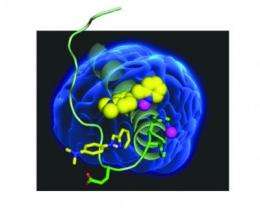Unraveling Alzheimer's: Simple small molecules could untangle complex disease

(PhysOrg.com) -- New molecular tools developed at the University of Michigan show promise for "cleansing" the brain of amyloid plaques, implicated in Alzheimer's disease.
A hallmark of Alzheimer's disease—a neurodegenerative disease with no cure—is the aggregation of protein-like bits known as amyloid-beta peptides into clumps in the brain called plaques. These plaques and their intermediate messes can cause cell death, leading to the disease's devastating symptoms of memory loss and other mental difficulties.
The mechanisms responsible for the formation of these misfolded proteins and their associations with Alzheimer's disease are not entirely understood, but it's thought that copper and zinc ions are somehow involved.
The research, led by assistant professor Mi Hee Lim, was published online Dec. 3 in the Proceedings of the National Academy of Science.
In earlier work, Lim and her team developed dual-purpose molecular tools that both grab metal ions and interact with amyloid-beta. The researchers went on to show that in solutions with or without living cells, the molecules were able to regulate copper-induced amyloid-beta aggregation, not only disrupting the formation of clumps, but also breaking up clumps that already had formed.
Building upon that first generation of compounds, Lim and lab members Jung-Suk Choi and Joseph Braymer now report a second generation of compounds that are more stable in biological environments. The researchers tested one of those compounds, described in the PNAS paper, in homogenized brain tissue samples from Alzheimer's disease patients.
"We found that our compound is capable of disassembling the misfolded amyloid clumps to form smaller amyloid pieces, which might be 'cleansed' from the brain more easily, demonstrating a therapeutic application of our compound," said Lim, who has joint appointments in the Life Sciences Institute and the Department of Chemistry. In addition, preliminary tests show that the bi-functional small molecules have a strong potential to cross the blood-brain barrier, the barricade of cells that separates brain tissue from circulating blood, protecting the brain from harmful substances in the bloodstream.
"Crossing this barrier is essential for any treatment like this to be successful," Lim said.
Next steps include more intensive testing of the new compounds for diagnostic and therapeutic properties.
Lim and her team collaborated with Ayyalusamy Ramamoorthy, professor of chemistry and biophysics on this work, with funding from the U-M Horace H. Rackham School of Graduate Studies, the Alzheimer's Art Quilt Initiative, and the National Institutes of Health.
More information: www.pnas.org/content/early/201 … 091107.full.pdf+html















